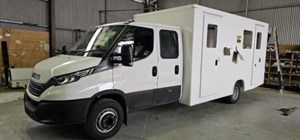The research trial is being delivered by Stroke Foundation, the Victorian Government, Ambulance Victoria, Melbourne Health, the Florey Institute of Neuroscience and Mental Health and The University of Melbourne. We're proud to be part of the consortium delivering this ground breaking, innovative research trial.
Updates
Eighty percent of strokes are caused by blood clots in the brain. Life-saving clot-busting drugs are available, but must be administered within 4.5 hours of a stroke occurring. It is vital that the type of stroke a patient has experienced is diagnosed quickly and accurately.
The stroke ambulance is a next generation solution to speed up diagnosis, deliver the most effective stroke treatment and generate powerful new research insights into stroke.
Quick facts
- A first-of-its-kind rapid response medical service for Australia.
- First Mobile Stroke Unit in the southern hemisphere.
- $8 million pilot project over five years starting in 2017.
- Innovative partnership between Stroke Foundation, Royal Melbourne Hospital, Ambulance Victoria, University of Melbourne and The Florey Institute of Neuroscience and Mental Health.
- The project is endorsed by the National Health and Medical Research Council.
- Results to be shared and promoted nationally.
What is a Mobile Stroke Unit?
- Looks like an ambulance but is more like an emergency department on wheels, designed to deliver expert stroke care to the patient at first response.
- Has the latest diagnostic technology built-in including a CT scanner, telemedicine equipment and mobile laboratory.
- Staffed by a neurologist, stroke nurse, radiographer and paramedic, the unit enables a specialist stroke-trained team to quickly evaluate a patient and immediately start treatment.
- Delivering life-saving blood clot-busting medication in the field rather than waiting for a patient to arrive at a hospital for this treatment to be administered.
- Ground-breaking research initiative.
More than a life-saving responder, this is also an innovative research laboratory
The Mobile Stroke Unit project will also generate valuable new data to help guide the future direction of acute stroke treatment such as:
- Studying the different patient outcomes that emerge between standard ambulance hospital admissions and Mobile Stroke Unit treatment.
- Learning how treatment times can affect life after stroke, such as how faster treatment might dramatically improve long-term patient outcomes.
- Testing new treatments for both major types of stroke – blocked blood vessel and bleeding – that are likely to be more effective when delivered early.
- Integrating the latest stroke telemedicine technology into ambulance response.
- Improving data-sharing with experts working on new stroke treatments and potential cures.
Australia’s first Mobile Stroke Unit
- CT scanner - A device that scans a stroke patient’s brain to determine what kind of stroke they are having and guide the decisions about administering the most effective treatment.
- Telemedicine technology on board - A state of the art, two-way audio visual communication system that connects neurologists at the hospital with experienced staff on board the ambulance to help examine, diagnose and recommend the best possible treatment.
- Clot-busting power - The Mobile Stroke Unit is equipped to deliver thrombolysis, a breakthrough drug treatment that dissolves blood clots. The faster an appropriate stroke patient receives this medication, the better the opportunity for a good outcome and less rehabilitation services required.
- Specialist stroke team - Experienced paramedics are joined by a neurologist, stroke nurse and radiographer allowing this specialist stroke team to quickly evaluate a patient and immediately start the best possible treatment.
- Research lab - The data collected by the stroke team will provide powerful new insights that will help to shape the future of stroke treatment and care in Australia.
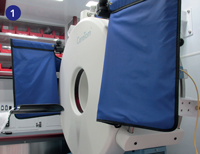
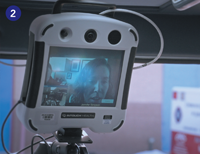
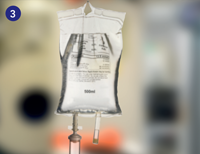
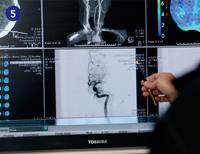
The international experience
- There are only a dozen Mobile Stroke Units currently operating in the world. All are in the northern hemisphere – including three in Germany and five in USA.
- Pilot studies have already shown that clot-busting thrombolysis treatment could safely and effectively be administered reducing treatment times by over 30 minutes compared to the standard hospital-treated patients.
- In Houston USA, 70 percent of patients were treated within 90 minutes of symptoms including 40 percent in the first hour, compared to less than one percent of hospital-treated stroke patients being treated in the first hour
- More patients treated in Mobile Stroke Units are delivered directly to hospitals with dedicated stroke services to treat the specific type of stroke a patient has experienced.
- UTHealth (Houston) is projecting $2-4 million savings in post-acute stroke therapy through faster recovery and more lives saved.
Why Australia needs this
- Time is critical – For every minute after stroke that treatment is delayed, up to 1.9 million brain cells die. Time = Brain.
- More patients accessing breakthrough clot-busting drugs – Only 13 percent of ischaemic stroke patients in Australia are receiving thrombolysis.
- Faster treatment with thrombolysis – For Australian stroke patients receiving this life-saving treatment, only 30 percent are getting it in the first 60 minutes of hospital arrival – significantly below international counterparts like USA (43 percent) and UK (56 percent). This treatment is most effective if given early (and no later than 4.5 hours after symptom onset).
- Bypass the emergency department – Earlier identification of patients eligible for clot retrieval surgery on board means they can proceed directly to treatment.
- Reduce health care burden – This project has the potential to be sustainable as the costs of the Mobile Stroke Unit will be offset by a reduction in the length of hospital stay, reduced disability and better outcomes from long-term recovery for stroke survivors.
- New research insights – With our research partners, the Mobile Stroke Unit will deliver new insights into treatment and opportunities for further research, including clinical trials, brain imaging and telemedicine.
- Hope for the future – The Mobile Stroke Unit will save lives and demonstrate its worth to be rolled out to other areas of Australia that will benefit from it.


